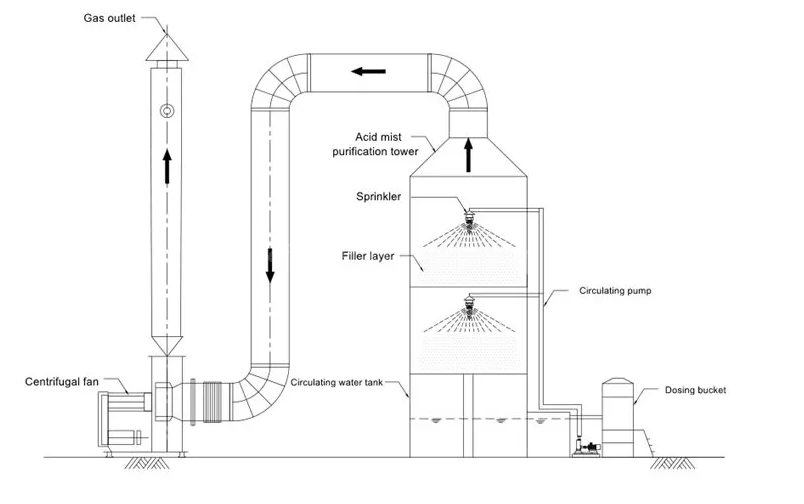- All
- Product Name
- Product Keyword
- Product Model
- Product Summary
- Product Description
- Multi Field Search
Views: 12 Author: Xicheng EP LTD Publish Time: 2023-10-16 Origin: Xicheng EP LTD

The processing efficiency of a wet scrubber can vary depending on the situation and the type of scrubber. Treatment efficiency is often affected by a variety of factors, including scrubber design, operating conditions, the nature and concentration of contaminants, etc. Typically, wet scrubbers are effective at removing contaminants from liquids or gases, but specific efficiency depends on the following factors:
Nature of contaminants: Different types of contaminants have different effects on the efficiency of wet scrubbers. Some contaminants may be easier to remove, while others may require more treatment to achieve the desired effect.
Scrubber types: There are many different types of wet scrubbers, including spray towers, packed towers, wet electrostatic precipitators, etc. Each type of scrubber has its own unique working principle and efficiency.
Scrubber design: The design parameters of wet scrubbers, such as filler shape, filler material, liquid flow rate, gas flow rate, etc., will affect the treatment efficiency.
Operating conditions: Operating conditions, such as liquid circulation rate, temperature, humidity, etc., also affect the efficiency of the scrubber.
Size and dimensions of the scrubber: The size and size of the scrubber affects its processing capacity and efficiency. Larger scrubbers can generally handle more contaminants.
Detergent Usage: Sometimes, the efficiency of a wet scrubber can be enhanced by using a specific type of detergent, especially for certain types of contaminants.
Due to differences in the above factors, processing efficiency will vary depending on the specific situation. In order to determine the treatment efficiency of a specific wet scrubber, experiments or monitoring are required to calculate the treatment efficiency based on the inlet concentration and outlet concentration, as described previously. Such data are typically evaluated and reported by environmental engineers, environmental agencies, or related industries.
The treatment efficiency of a wet scrubber is usually calculated by the following formula:
Treatment efficiency = (Inlet concentration - Outlet concentration) / Inlet concentration
Inlet concentration refers to the initial concentration of contaminants in the liquid or gas to be treated.
The outlet concentration refers to the final concentration of contaminants in the liquid or gas after being processed by the scrubber.
Processing efficiency calculations are usually expressed as a percentage, so you may need to multiply the result by 100 to get a value in percentage form.

This formula can be used to evaluate a wet scrubber's removal efficiency, that is, how much contaminants it can remove from a fluid. The higher the treatment efficiency, the better the performance of the scrubber and its ability to remove contaminants more effectively.
To provide the treatment efficiency of a wet scrubber, it is usually necessary to conduct a series of experiments and measurements, and then calculate the efficiency value based on the experimental data. The following are general steps for improving wet scrubber processing efficiency:
Determine the inlet concentration: First, you need to measure the initial concentration of the contaminant in the liquid or gas to be treated. This can be done through laboratory testing or on-site monitoring.
Determine the outlet concentration: Next, you need to measure the final concentration of the contaminant in the liquid or gas after the scrubber process. This can again be accomplished through laboratory testing or on-site monitoring.
Use the calculation formula: Substitute the inlet concentration and outlet concentration into the treatment efficiency formula mentioned earlier to calculate the treatment efficiency. Usually expressed as a percentage.
Multiple measurements: To ensure the accuracy of your results, it is best to take multiple measurements to get an average. This reduces errors and uncertainties.
Recording and reporting: Processing efficiency calculations are documented and provided to relevant stakeholders or regulators. Typically, this data is used in environmental impact assessments, permit applications or reports.

It should be noted that the treatment efficiency of a wet scrubber can be affected by a variety of factors, including scrubber design, operating conditions, and the nature of the pollutants. Therefore, when presenting processing efficiency data, sufficient background information needs to be provided so that others can understand the experimental conditions and parameters. Additionally, ensure that appropriate instruments and methods are used for measurements and analysis to increase the confidence of the results.
| | N0.34 Zhenxing Road (Shengtaian Heavy Industrial Park B), Loucun, Guangming New Dist, Shenzhen, Guangdong, China |
| | +86 18028775826 |
| | Leyte@china-xicheng.com |